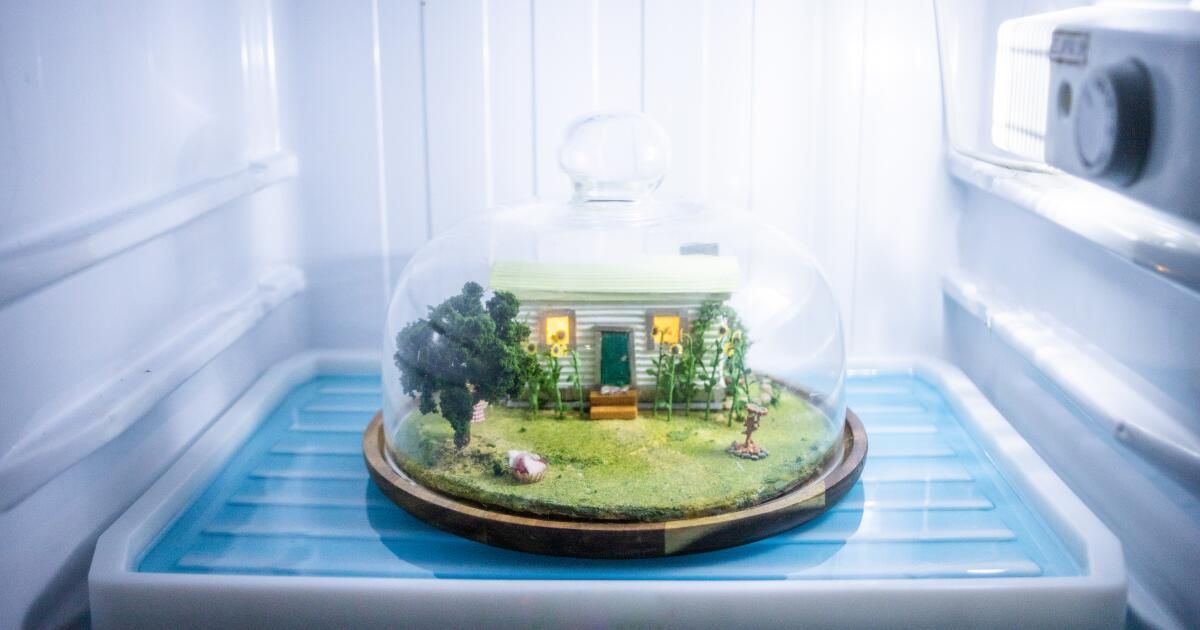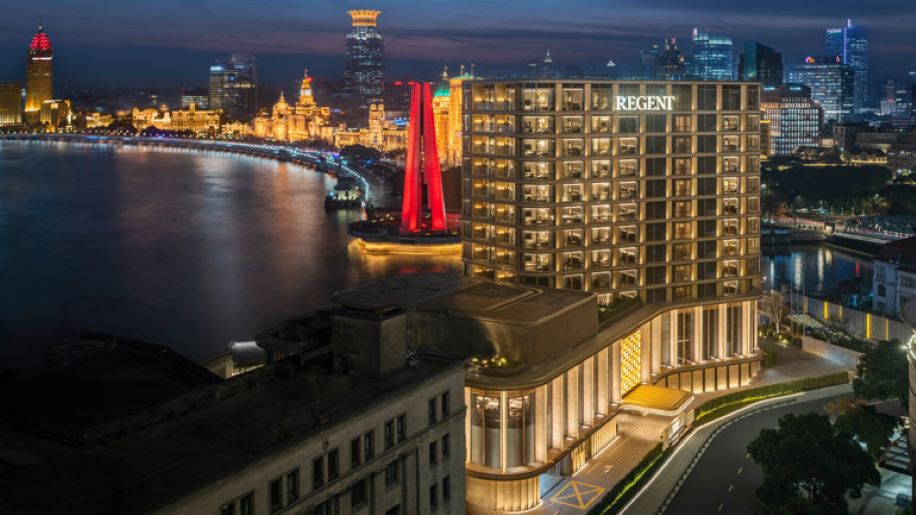“Great Gold Bird,” a theater production taking place at various locations in Los Angeles, begins inside my house. It begins with a mystery, presenting itself as a missing persons story. However, it is also an enigma.
Henry, we are told, has disappeared. Only he didn't suddenly disappear. I am now an active investigator, as the protagonist has intentionally left a trail of clues.
“Great Gold Bird” can be heavy, tugging at our hearts even as it becomes more mystical: its themes bounce between grief, science fiction and spiritualism. Twice he brought me to tears, his script felt both deeply personal and universal to anyone who has survived a significant loss. And yet it has an underlying narrative drive, an attraction to discovering its secrets that transcends any sense of sadness.
The story is one of magical realism focused on grief, that is, the quest to reconnect with a lost loved one. The character of Jen, played by Kristin Degroot, appears in the painting.
(Todd Martens / Los Angeles Times)
Because “Great Gold Bird” is a play, but not in the traditional sense. Think of it more like a real-life video game, one that uses light puzzles to drive the story and create a sense of exploration. A “wandering game,” as its designer calls it.
“Great Gold Bird” takes place in three locations, including the audience members' initial place of residence. Where to go next is revealed through the narrative: an address unlocked after examining a website dedicated to a lost love, or a map discovered in a locked chest after discovering its combination. This sense of play is key, as it allows “Great Gold Bird” to delve into the realities of living with prolonged grief—its delusions, its isolating nature, and its fantastical hopes—without feeling overbearing. By turning the audience into participants, we ourselves are driven by the desire to reach a healing conclusion.
It begins with an online shrine, a fictional website that the character Henry (Josh Meyer) has created to preserve the memories of his late wife, Jen (Kristin Degroot). From there we are taken to what we are told is Henry's caravan, a fantastically cozy abode full of miniature facilities and hidden corners. We're on the loose, looking for clues that lead us to Henry's messages. The first is clearly visible, but soon we will be exploring every inch of the vehicle in search of secret hiding places.

Inside a caravan, participants search for clues that may lead them to messages from Henry.
(Twin Alchemy Collective)
The RV is parked in a secure lot in Arlington Heights. Since the precise direction is revealed as you progress through the narrative (none of the puzzles are particularly challenging, but there is a clue system in the story, if necessary), I choose to preserve some of the secrets of the “Great Golden Bird” , but you should know. that it is a scheduled experience on weekend nights and that there will be a host who will greet you at the first place. The ending is more of a self-guided nature walk, as the play will take us to a designated area around Griffith Park where various props have been placed.
“Great Gold Bird” instantly hooked me, its writing echoing phrases I myself had said when I was in the throes of pain. We meet Henry, who is struggling, even panicking, as he realizes that memories centered on his past relationship are fading. “The prospect of losing my wife a second time—not just our future but the slow erosion of our past—terrified me,” Henry writes in a letter to his niece, which prompted him to undertake a writing exercise to create a website dedicated to your time together.
I found this immediately relatable, and not just because I spent many months on a similar project dedicated to a past relationship. But it focuses on a particularly torturous way that pain can pierce us. Grief can become dangerous when we begin to find the past more comforting than reality, which is not difficult to do when it comes to the loss of someone close to us. I, too, was terrified of forgetting any memory of a past relationship, so I spent almost two years documenting every moment I could remember as if it were a fairy tale. But to do this is to turn pain into our personality, and that is precisely what Henry does in “The Big Golden Bird.”
“Great Gold Bird,” recommended for an intimate audience of one or two people, has a fixed price of $120 per show. It's also a production that becomes more surreal as it progresses, although I felt its handling of grief was particularly grounded. This makes sense, as the project, from Katie Green's Twin Alchemy Collective, is born from both personal reflection and professional research.

The caravan is full of hidden corners that allow participants to reconstruct the narrative.
(Todd Martens / Los Angeles Times)
Green, in her day job, is a practicing mental health therapist. “I'm really interested, even more so once I started becoming a therapist, in this intersection between immersive art and how it can be a vehicle for hopefully transformative experiences and for confronting very real and personal things, like the relationship with the pain or death,” Green said. says.
Once “Great Gold Bird” establishes its premise of angst, it begins to spiral, touching on metaphysical themes that make us question our own reality. Henry discovers experimental meditation techniques, and for a time, “Great Gold Bird” makes us ponder whether Henry is deluding himself or whether he has truly found a way to communicate with his lost love. Daydreaming, after all, is powerful, and as “Great Gold Bird” gets stranger (we're soon scouring the trailer looking for hidden rooms, searching for VHS tapes and trying to decipher maps of Los Angeles), “Great Gold Bird” becomes a magical realism story.
In this sense, “Great Gold Bird” will recall another long-running immersive show in Los Angeles, “The Nest,” created by Scout Expedition, currently playing at Hatch Escapes. Both Scout and Hatch helped bring “Great Gold Bird” to Los Angeles, as Green is based in Austin, Texas, where he has been directing various incarnations of “Great Gold Bird” for about a decade.
Like “The Nest,” “Great Gold Bird,” out in December, was influenced by exploratory video games like “Gone Home,” in which players search for personal items to uncover the story of two brothers and the Area of the Bay. alternate reality game (ARG) “The Jejune Institute,” which was captured in a 2012 documentary. Green, 35, says he even spent about five years trying to turn “Great Gold Bird” into a video game.
“My two biggest inspirations for the first version of this back in 2013 were playing 'Gone Home' and 'The Jejune Institute,' watching that documentary and hearing about that second-hand footage and wondering what it would be like to create a live-action environmental film. . narrative experience that also went beyond a space and was a little more fluid with space and time,” says Green. “It's like an ARG, but on rails.”
Initially, Green wanted “Great Gold Bird” to visit a third location in Los Angeles, but the realities of traffic and travel time kept it confined to two spaces outside our homes. The project does not have to be completed on the same day. In fact, realizing that it would take me an hour to get from Arlington Heights to the Los Feliz area on a Friday night, I opted to finish “Great Gold Bird” the day after I started it. That worked for me, since “Great Gold Bird” is designed for contemplation and I wanted time to process its grief management.
Although “Great Gold Bird” focuses on the death of a loved one, Green says it was largely inspired by the breakdown of romantic relationships. “I make art to try to understand things I still don't fully understand, and the pain I felt from major breakups is my closest approximation of that,” Green says. “I did this for other people to process their own relationship with grief, whether it's the death of a person, the death of a relationship, or the death of some part of their identity.”
Ultimately, that's why “Great Gold Bird” resonates. We, as spectators turned actors, are on the hunt for a lost soul, a soul that has to rediscover who it is.












